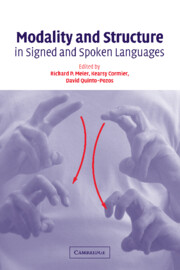Book contents
- Frontmatter
- Contents
- List of figures
- List of tables
- List of contributors
- Acknowledgements
- 1 Why different, why the same? Explaining effects and non-effects of modality upon linguistic structure in sign and speech
- Part I Phonological structure in signed languages
- 2 Modality differences in sign language phonology and morphophonemics
- 3 Beads on a string? Representations of repetition in spoken and signed languages
- 4 Psycholinguistic investigations of phonological structure in ASL
- 5 Modality-dependent aspects of sign language production: Evidence from slips of the hands and their repairs in German Sign Language
- 6 The role of Manually Coded English in language development of deaf children
- Part II Gesture and iconicity in sign and speech
- Part III Syntax in sign: Few or no effects of modality
- Part IV Using space and describing space: Pronouns, classifiers, and verb agreement
- Index
- References
3 - Beads on a string? Representations of repetition in spoken and signed languages
Published online by Cambridge University Press: 22 September 2009
- Frontmatter
- Contents
- List of figures
- List of tables
- List of contributors
- Acknowledgements
- 1 Why different, why the same? Explaining effects and non-effects of modality upon linguistic structure in sign and speech
- Part I Phonological structure in signed languages
- 2 Modality differences in sign language phonology and morphophonemics
- 3 Beads on a string? Representations of repetition in spoken and signed languages
- 4 Psycholinguistic investigations of phonological structure in ASL
- 5 Modality-dependent aspects of sign language production: Evidence from slips of the hands and their repairs in German Sign Language
- 6 The role of Manually Coded English in language development of deaf children
- Part II Gesture and iconicity in sign and speech
- Part III Syntax in sign: Few or no effects of modality
- Part IV Using space and describing space: Pronouns, classifiers, and verb agreement
- Index
- References
Summary
Introduction
Someone idly thumbing through an English dictionary might observe two characteristics of repetition in words. First, segments can vary in the number of times they repeat. In no, Nancy, unintended, and untentional, /n/ occurs one, two, three, and four times respectively. In the minimal triplet odder, dodder, and doddered, /d/ occurs one, two, and three times.
A second characteristic is that words repeat rhythmically or irregularly:
Rhythmic repetition: All the segments of a word can be temporally sliced to form at least two identical subunits, with patterns like aa, abab, and ababab. Examples: tutu (abab), murmur (abcabc).
Irregular repetition: any other segment repetition, such as abba, aabb, abca, etc. Examples: tint (abca), murmuring (abcabcde).
If asked to comment on these two characteristics, a phonologist might shrug and quote from a phonology textbook:
[An] efficient system would stipulate a small number of basic atoms and some simple method for combining them to produce structured wholes. For example, two iterations of a concatenation operation on an inventory of 10 elements … will distinguish 103 items … As a first approximation, it can be said that every language organizes its lexicon in this basic fashion. A certain set of speech sounds is stipulated as raw material. Distinct lexical items are constructed by chaining these elements together like beads on a string.
(Kenstowicz 1994:13)Repetition, the phonologist might say, is the meaningless result of the fact that words have temporal sequences constructed from segments.
- Type
- Chapter
- Information
- Modality and Structure in Signed and Spoken Languages , pp. 65 - 87Publisher: Cambridge University PressPrint publication year: 2002
References
- 5
- Cited by



